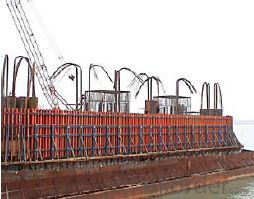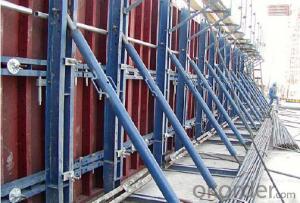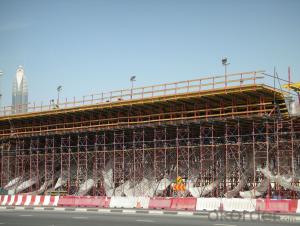Single-side Climbing Bracket SCB180 for formwork and scaffolding system
- Loading Port:
- Tianjin
- Payment Terms:
- TT OR LC
- Min Order Qty:
- 50 m²
- Supply Capability:
- 1000 m²/month
OKorder Service Pledge
OKorder Financial Service
You Might Also Like
Single-side Climbing Bracket SCB180:
With CNBM SCB 180 climbing systems, the loads from the fresh concrete pressure are transferred through the brackets by means of V-strongbacks and compression braces into the scaffold anchors.
Typical applications for the SCB 180 are dams, locks, cooling towers, pier heads, tunnels, and bank vaults.
The formwork is simply tilted backwards when striking takes place. The 1.80 m wide bracket requires only a minimum of space.
Characteristics:
◆ Economical and safe anchoring
The M30/D20 climbing cones have been designed especially for single-sided concreting using
SCB180 in dam construction, and to allow the transfer of high tensile and shear forces into the still
fresh, unreinforced concrete. Without wall-through tie-rods, finished concrete is perfect.
◆ Stable and cost-effective for high loads
generous bracket spacings allow large-area formwork units with optimal utilization of the bearing
capacity. This leads to extremely economical solutions.
◆ Simple and flexible planning
With SCB180 single-sided climbing formwork, circular structures can also be concreted without
undergoing any large planning process. Even use on inclined walls is feasible without any special
measures because additional concrete loads or lifting forces can be safely transferred into the
structure.
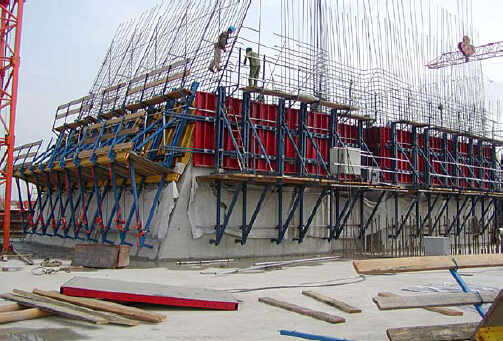
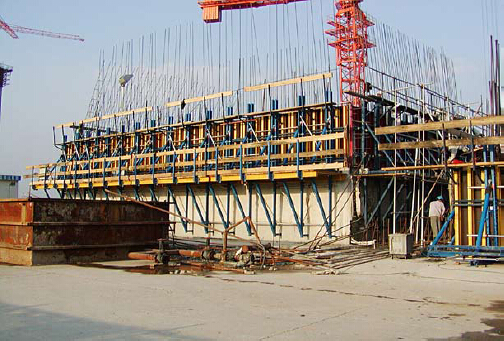
- Q: Is steel formwork suitable for high-rise construction?
- High-rise construction can indeed utilize steel formwork, which offers numerous advantages. Firstly, steel formwork possesses exceptional strength and durability, enabling it to withstand the immense pressures and loads associated with tall building construction. This feature ensures the safety and stability of the structure throughout the construction process. Secondly, steel formwork boasts exceptional versatility, allowing for easy customization to meet the specific requirements of high-rise construction. It can be designed and fabricated into various shapes and sizes, providing flexibility in creating different structural elements like walls, columns, and slabs. This adaptability facilitates efficient construction and minimizes the need for extensive modifications or adjustments. Moreover, the reusability of steel formwork makes it a cost-effective option for high-rise construction projects. By eliminating the constant need for new formwork materials, the overall construction costs are reduced. This sustainability aspect also contributes to minimizing waste and promoting resource efficiency. Furthermore, steel formwork ensures high-quality construction for high-rise buildings through its ability to provide a smooth and even surface finish. This characteristic eliminates the requirement for extensive plastering or finishing works, saving time and resources during the construction process. In conclusion, steel formwork is an excellent choice for high-rise construction due to its strength, versatility, reusability, and ability to provide a smooth finish. These qualities make it an ideal option for efficiently and effectively constructing tall buildings.
- Q: How does steel formwork impact the overall project management?
- Steel formwork can have a significant impact on the overall project management in various ways. First and foremost, steel formwork is known for its durability and longevity, which means it can be reused multiple times throughout the project. This reduces the need for frequent replacements and repairs, saving both time and money. Moreover, steel formwork provides a high level of accuracy and precision, ensuring that the concrete structures are built according to the specified dimensions and specifications. This not only enhances the quality of the project but also minimizes the chances of rework or corrective measures, thereby saving time and resources. Additionally, steel formwork offers greater flexibility and versatility compared to traditional wooden formwork. It can be easily adjusted and modified to accommodate changes in design or unforeseen circumstances during the construction process. This adaptability enables project managers to make on-site adjustments quickly and efficiently, keeping the project on track and minimizing delays. Furthermore, steel formwork is known for its faster installation and dismantling process. This allows for faster construction cycles, enabling project managers to meet tight deadlines and complete the project within the scheduled timeframe. The faster turnaround time also improves project efficiency and reduces overall project costs. Lastly, steel formwork is considered a safer option compared to other formwork materials. It provides a stable and secure platform for workers, minimizing the risk of accidents and injuries. By prioritizing worker safety, project managers can maintain a productive and efficient work environment. In conclusion, steel formwork has a positive impact on overall project management by enhancing durability, accuracy, flexibility, speed, and safety. Utilizing steel formwork can lead to improved project outcomes, reduced costs, and enhanced efficiency, ultimately contributing to the successful completion of the project.
- Q: What is the maximum concrete pressure that steel formwork can withstand?
- The maximum concrete pressure that steel formwork can withstand depends on various factors such as the thickness and type of steel used, the design and construction of the formwork, and the quality of the concrete being poured. However, in general, steel formwork can withstand concrete pressures ranging from 50 to 100 kN/m2 (725 to 1450 psi).
- Q: What are the common design considerations for steel formwork in seismic areas?
- To ensure the safety and stability of structures in seismic areas, there are several important factors to consider when designing steel formwork. These factors include: 1. Material strength: It is crucial to use steel with high tensile strength and ductility to withstand seismic forces. Utilizing high-strength steel, like Grade 60 or Grade 80, is often necessary to ensure the formwork can endure the lateral forces generated during earthquakes. 2. Connection details: The connections between different components of the steel formwork must be meticulously designed to withstand seismic loads. Employing proper welding or bolting techniques is essential to ensure the connections are strong enough to resist dynamic forces. 3. Reinforcement: To enhance the structural integrity of the formwork, additional reinforcement such as steel bars or mesh may be required. This reinforcement helps distribute seismic forces and prevents the formation of weak points or failure zones. 4. Stiffness and rigidity: The formwork system should be designed to be adequately stiff and rigid, minimizing deformations and preventing excessive movement during earthquakes. This can be achieved by using thicker steel plates or incorporating diagonal bracing elements to increase overall stiffness. 5. Anchorage and support: To prevent shifting or collapsing during seismic events, the formwork needs to be securely anchored to the ground or supporting structure. Incorporating adequate anchorage and support systems, such as anchor bolts or braces, into the design is crucial for formwork stability. 6. Compatibility with other building components: Consideration must be given to the compatibility of the steel formwork with other structural elements, such as concrete walls or columns. Proper coordination and integration with other building components are essential for overall stability and seismic performance. 7. Robustness and redundancy: The formwork design should incorporate features that provide redundancy and robustness, enabling it to withstand unexpected loading conditions or localized damage during earthquakes. This can be achieved by incorporating multiple load paths or redundant structural elements into the formwork system. In summary, the design considerations for steel formwork in seismic areas revolve around ensuring strength, stability, and compatibility with other components. By addressing these factors, engineers can develop robust and resilient formwork designs that contribute to the overall seismic safety of the structure.
- Q: How does steel formwork handle formwork stability during concrete pouring?
- Steel formwork provides excellent formwork stability during concrete pouring due to its high strength and rigidity. It can withstand the pressure and weight of the fresh concrete without deformation or collapse, ensuring the desired shape and structure of the concrete elements. Additionally, steel formwork can be easily adjusted and secured in place, allowing for precise alignment and stability during the pouring process.
- Q: How does steel formwork affect the overall architectural aesthetics of the structure?
- Steel formwork can have a significant impact on the overall architectural aesthetics of a structure. The use of steel as a material for formwork can provide a sleek and modern appearance to the building. Its smooth and rigid surface allows for precise and clean lines, resulting in a more refined and elegant look. Steel formwork also offers great flexibility in terms of design possibilities. It can be easily shaped and molded into complex and intricate patterns, allowing architects to create unique and visually appealing structures. This versatility opens up a wide range of architectural possibilities, enabling the creation of buildings with distinct and eye-catching features. Furthermore, steel formwork provides a high level of structural stability, which enhances the overall aesthetics of the structure. The use of steel ensures that the formwork remains strong and sturdy, even under heavy loads, which is crucial for creating large and imposing architectural designs. The ability to use steel formwork in such constructions allows architects to achieve bold and impressive architectural forms that might not be possible with other materials. In addition to its visual impact, steel formwork also offers various practical advantages. It is a durable and long-lasting material that can withstand harsh weather conditions, making it suitable for both indoor and outdoor applications. Steel formwork is also highly resistant to fire, corrosion, and pests, further ensuring the longevity and integrity of the structure. Overall, steel formwork plays a crucial role in shaping the architectural aesthetics of a structure. Its smooth surface, flexibility in design, structural stability, and durability contribute to creating visually appealing and iconic buildings. By choosing steel formwork, architects can achieve both functional and aesthetic goals, resulting in structures that are not only beautiful but also reliable and long-lasting.
- Q: How is steel formwork cleaned and maintained?
- Steel formwork can be cleaned and maintained by removing any concrete residue using a high-pressure water jet or wire brush. After cleaning, it should be inspected for any damages or rust, and if found, repaired or repainted accordingly. Regular lubrication of moving parts and proper storage in a dry environment also helps to extend its lifespan.
- Q: How does steel formwork prevent concrete spillage?
- Steel formwork prevents concrete spillage by providing a strong and rigid structure that holds the wet concrete in place during the pouring and curing process. The steel panels create a tight enclosure around the concrete, preventing any leakage or spillage, ensuring that the concrete is properly contained within the desired shape and form.
- Q: How does steel formwork compare to timber formwork in terms of durability?
- Steel formwork is generally considered to be more durable than timber formwork. Steel is a strong and resilient material that is able to withstand heavy loads and high pressures without warping or deteriorating. Unlike timber, steel does not rot, warp, or shrink when exposed to moisture or extreme weather conditions. This makes steel formwork suitable for use in various construction projects, including high-rise buildings, bridges, and tunnels, where durability is essential. Additionally, steel formwork has a longer lifespan than timber formwork. Steel is known for its longevity and ability to maintain its structural integrity over time. It does not require frequent replacement or repairs, resulting in cost savings in the long run. Timber formwork, on the other hand, may need to be replaced more frequently due to wear and tear, moisture damage, or insect infestation. Furthermore, steel formwork offers greater flexibility and adaptability. It can be easily fabricated into different shapes and sizes to meet the specific requirements of each construction project. This adaptability allows for efficient and precise construction, reducing labor and material costs. Overall, while timber formwork can be cost-effective and suitable for certain applications, steel formwork is generally considered to be more durable, long-lasting, and versatile. It provides a reliable and resilient solution for construction projects that require high strength and durability.
- Q: Can steel formwork be used for projects with high concrete durability demands?
- Yes, steel formwork can be used for projects with high concrete durability demands. Steel formwork is known for its strength, durability, and longevity, making it suitable for demanding construction projects. It can withstand heavy loads and provide the necessary support for the concrete during the curing process. Steel formwork also offers excellent dimensional stability, ensuring the accuracy and consistency of the concrete structure. Additionally, steel formwork can be reused multiple times, reducing waste and project costs. However, it is important to ensure proper maintenance and corrosion protection of the steel formwork to maximize its durability and ensure long-term performance.
Send your message to us
Single-side Climbing Bracket SCB180 for formwork and scaffolding system
- Loading Port:
- Tianjin
- Payment Terms:
- TT OR LC
- Min Order Qty:
- 50 m²
- Supply Capability:
- 1000 m²/month
OKorder Service Pledge
OKorder Financial Service
Similar products
Hot products
Hot Searches



